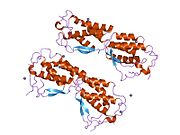Biology:FMS-like tyrosine kinase 3 ligand
 Generic protein structure example |
Fms-related tyrosine kinase 3 ligand (FLT3LG) is a protein which in humans is encoded by the FLT3LG gene.[1][2][3]
Flt3 ligand (FL) is a hematopoietic four helical bundle cytokine. It is structurally homologous to stem cell factor (SCF) and colony stimulating factor 1 (CSF-1). In synergy with other growth factors, Flt3 ligand stimulates the proliferation and differentiation of various blood cell progenitors. For example, it is a major growth factor stimulating the growth of dendritic cells.[4]
FLT3L functions as a cytokine and growth factor that increases the number of immune cells (lymphocytes (B cells and T cells)) by activating the hematopoietic progenitors. It acts by binding to and activating FLT3 (CD135) which is found on what (in mice) are called multipotent progenitor (MPP) and common lymphoid progenitor (CLP) cells. It also induces the mobilization of the hematopoietic progenitors and stem cells in vivo which may help the system to kill cancer cells.[5]
FLT3L is crucial for steady-state plasmacytoid dendritic cell (pDC) and classical dendritic cell (cDC) development.[5][6] A lack of FLT3L results in low levels of dendritic cells.
In parasite clearance
FLT3L and its receptor are involved in the mammalian immune response to malaria. In strains of plasmodium, FLT3L was shown to be released from mast cells and cause the expansion of dendritic cells, leading to the activation of CD8+ T cells. The same paper suggested that FLT3L release was caused by stimulation of mast cells with uric acid, produced from a precursor secreted by the plasmodium parasite. .[7]
In immunotherapy
In situ vaccine (ISV), combining Flt3L, local radiotherapy, and a TLR3 agonist (poly-ICLC), could recruit, antigen-load and activate intratumoral cross-presenting dendritic cells (DCs) in indolent non-Hodgkin’s lymphomas (iNHLs) treatment (clinical trial: NCT01976585).[8] In this study, intratumoral Flt3L was able to (1) induce the accumulation of large numbers of TLR3+ DCs in the tumor and (2) mediate , together with local irradiation, cross-presentation of TAA by DCs in vitro and in vivo.
References
- ↑ "Entrez Gene: FLT3LG fms-related tyrosine kinase 3 ligand". https://www.ncbi.nlm.nih.gov/sites/entrez?Db=gene&Cmd=ShowDetailView&TermToSearch=2323.
- ↑ "Ligand for FLT3/FLK2 receptor tyrosine kinase regulates growth of haematopoietic stem cells and is encoded by variant RNAs". Nature 368 (6472): 643–648. April 1994. doi:10.1038/368643a0. PMID 8145851. Bibcode: 1994Natur.368..643H.
- ↑ "Identification of soluble and membrane-bound isoforms of the murine flt3 ligand generated by alternative splicing of mRNAs". Oncogene 10 (1): 149–157. January 1995. PMID 7824267.
- ↑ "Flt3 ligand regulates dendritic cell development from Flt3+ lymphoid and myeloid-committed progenitors to Flt3+ dendritic cells in vivo". The Journal of Experimental Medicine 198 (2): 305–313. July 2003. doi:10.1084/jem.20030323. PMID 12874263.
- ↑ 5.0 5.1 "Steady-state and inflammatory dendritic-cell development". Nature Reviews. Immunology 7 (1): 19–30. January 2007. doi:10.1038/nri1996. PMID 17170756.
- ↑ "Dendritic cells and liver fibrosis". Biochimica et Biophysica Acta (BBA) - Molecular Basis of Disease 1832 (7): 998–1004. July 2013. doi:10.1016/j.bbadis.2013.01.005. PMID 23313573.
- ↑ "Inflammatory Flt3l is essential to mobilize dendritic cells and for T cell responses during Plasmodium infection". Nature Medicine 19 (6): 730–738. June 2013. doi:10.1038/nm.3197. PMID 23685841.
- ↑ "Systemic clinical tumor regressions and potentiation of PD1 blockade with in situ vaccination". Nature Medicine 25 (5): 814–824. May 2019. doi:10.1038/s41591-019-0410-x. PMID 30962585.
Further reading
- "Delivery of Flt3 ligand (Flt3L) using a poloxamer-based formulation increases biological activity in mice". Bone Marrow Transplantation 31 (5): 361–369. March 2003. doi:10.1038/sj.bmt.1703816. PMID 12634727.
External links
 |


